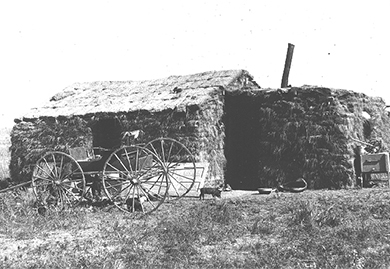| << Chapter < Page | Chapter >> Page > |
The first houses built by western settlers were typically made of mud and sod with thatch roofs, as there was little timber for building. Rain, when it arrived, presented constant problems for these sod houses , with mud falling into food, and vermin, most notably lice, scampering across bedding ( [link] ). Weather patterns not only left the fields dry, they also brought tornadoes, droughts, blizzards, and insect swarms. Tales of swarms of locusts were commonplace, and the crop-eating insects would at times cover the ground six to twelve inches deep. One frequently quoted Kansas newspaper reported a locust swarm in 1878 during which the insects devoured “everything green, stripping the foliage off the bark and from the tender twigs of the fruit trees, destroying every plant that is good for food or pleasant to the eye, that man has planted.”

Farmers also faced the ever-present threat of debt and farm foreclosure by the banks. While land was essentially free under the Homestead Act, all other farm necessities cost money and were initially difficult to obtain in the newly settled parts of the country where market economies did not yet fully reach. Horses, livestock, wagons, wells, fencing, seed, and fertilizer were all critical to survival, but often hard to come by as the population initially remained sparsely settled across vast tracts of land. Railroads charged notoriously high rates for farm equipment and livestock, making it difficult to procure goods or make a profit on anything sent back east. Banks also charged high interest rates, and, in a cycle that replayed itself year after year, farmers would borrow from the bank with the intention of repaying their debt after the harvest. As the number of farmers moving westward increased, the market price of their produce steadily declined, even as the value of the actual land increased. Each year, hard-working farmers produced ever-larger crops, flooding the markets and subsequently driving prices down even further. Although some understood the economics of supply and demand, none could overtly control such forces.
Eventually, the arrival of a more extensive railroad network aided farmers, mostly by bringing much-needed supplies such as lumber for construction and new farm machinery. While John Deere sold a steel-faced plow as early as 1838, it was James Oliver’s improvements to the device in the late 1860s that transformed life for homesteaders. His new, less expensive “chilled plow” was better equipped to cut through the shallow grass roots of the Midwestern terrain, as well as withstand damage from rocks just below the surface. Similar advancements in hay mowers, manure spreaders, and threshing machines greatly improved farm production for those who could afford them. Where capital expense became a significant factor, larger commercial farms—known as “ bonanza farms ”—began to develop. Farmers in Minnesota, North Dakota, and South Dakota hired migrant farmers to grow wheat on farms in excess of twenty thousand acres each. These large farms were succeeding by the end of the century, but small family farms continued to suffer. Although the land was nearly free, it cost close to $1000 for the necessary supplies to start up a farm, and many would-be landowners lured westward by the promise of cheap land became migrant farmers instead, working other peoples’ land for a wage. The frustration of small farmers grew, ultimately leading to a revolt of sorts, discussed in a later chapter.

Notification Switch
Would you like to follow the 'U.s. history' conversation and receive update notifications?